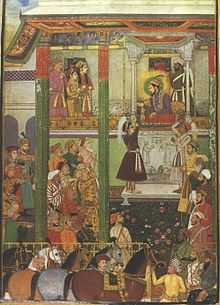Padshahnama

The Padshahnama (Persian: پا د شاه نا مہ) (Chronicle of the Emperor) is a genre of works written as the official visual history of Mughal Emperor, Shah Jahan’s reign. Most significant work of this genre was written by Abdul Hamid Lahori in two volumes.[2]
History
Shah Jahan in his eighth regnal year asked Muhammad Amin Qazvini to write an official history of his reign and he completed his Padshahnama in 1636, which covers the first ten (lunar) years of Shah Jahan’s reign.[2]
Jalaluddin Tabatabai wrote another Padshahnama, but the extant portion of the text covers only four years, from fifth to eighth regnal year of the emperor. The project was later given to Abdul Hamid Lahori, who wrote his Padshahnama in two volumes. The first volume of this work is based upon Qazvini’s work but has more details. The second volume covers the next ten (lunar) years of Shah Jahan’s reign. He completed his work in 1648. Lahori died in 1654. Muhammad Waris, a pupil of Lahori was given the responsibility to complete the task and his Padshahnama (completed in 1656) covers the rest of the period of Shah Jahan’s reign. His work was published by the Asiatic Society as the third volume of the Padshahnama of Lahori.
These works are the major sources of information about the Shah Jahan's period. The illustrations and paintings in the manuscripts of these works illuminate life in the Shah's court, depicting weddings and other activities.
Extant manuscripts
In 1799, The Nawab (provincial governor) of Oudh in northern India sent the Padshahnama, to King George III of England . Today, the imperial illustrated manuscript of the Padshahnama of Lahori is preserved in the Royal Library at Windsor Castle. The manuscripts of the Padshahnamas of Qazvini and Waris are preserved in the British Library.
A manuscript of the Padshahnama is also with the Khuda Bakhsh Oriental Library, Patna, India.[3]
Gallery
-

The Mughal Emperor Shah Jahan receives Persian Safavid ambassadors in the year 1636.[1]
-
.jpg)
The Mughal commander Khan Dauran captures the Fort at Udgir.
-
.jpg)
The Mughal Army captures Daulatabad fort in the year 1633.
-
.jpg)
Mughal commander Azim Khan captures Dharur.
-
_facing_a_maddened_elephant_named_Sudhakar_(7_June_1633).jpg)
Prince Aurangzeb riding against the maddened War elephant Sudhakar in the year 1633.[2]
-
.jpg)
The siege of the Safavid garrison at Kandahar (May 1631)
- ^ Abdul Hamid Lahori (1636). "Shah Jahan Receives Persian Ambassadors". Padshahnama.
- ^ Abdul Hamid Lahori (1636). "Prince Awrangzeb (Aurangzeb) facing a maddened elephant named Sudhakar". Padshahnama.
Work online
- Lahori, Abdul Hamid (1875). Badshanama of Abdul Hamid Lahori. tr. by Henry Miers Elliot. Hafiz Press, Lahore.
- Bádsháh-Náma of 'Abdu-L Hamíd Láhorí Packard Humanities Institute
See also
References
- ↑ "The Surrender of Kandahar". Padshahnama. 1640.
|first1=missing|last1=in Authors list (help) - ↑ 2.0 2.1 Majumdar, R. C. (ed.) (2007). The Mughul Empire, Mumbai: Bharatiya Vidya Bhavan, ISBN 81-7276-407-1, p.9
- ↑ "Islamic knowledge house, Khuda Bakhsh Library retains glory". Outlook (magazine). Jul 8, 2005.
Further reading
- The King of the World: The Padshahnama: An Imperial Mughal Manuscript from the Royal Library, Windsor Castle, Thames & Hudson. 1997. ISBN 0-500-97448-9.
- Kossak , Steven (1997). Indian court painting, 16th-19th century.. New York: The Metropolitan Museum of Art. ISBN 0870997831. (see index: p. 148-152; plate 25)
.jpg)